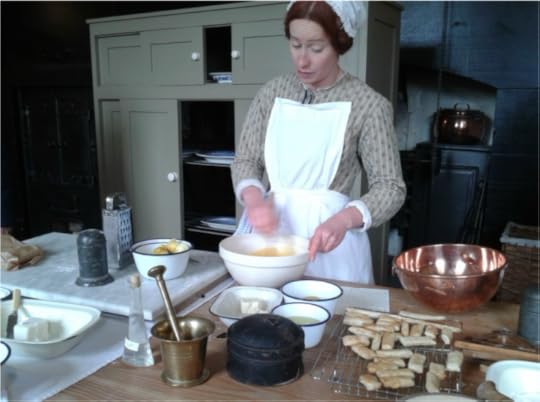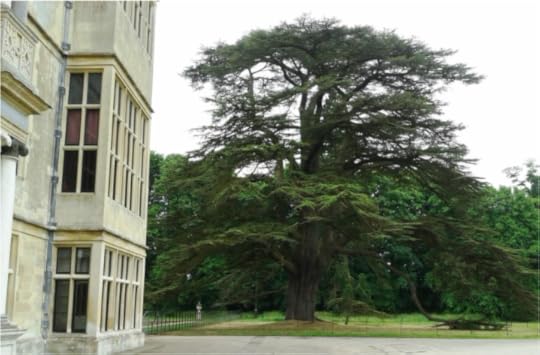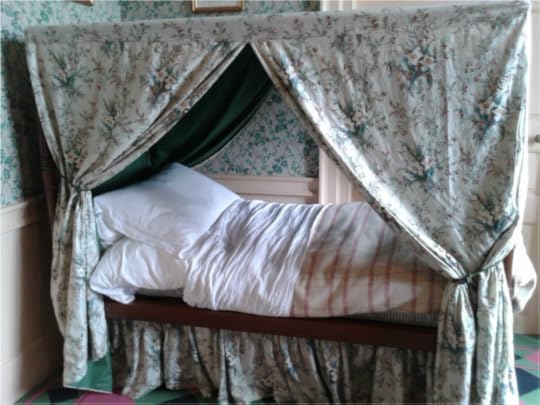Audley End
 Cook in the Kitchen A visit to Audley End had been on my wish-list for years, so a recent gift of a year’s entry to English Heritage properties combined with a friend’s birthday celebration in Maldon, Essex, gave me all the impetus I needed. We were lucky enough to arrive on Audley in Bloom day, with music from the Saffron Walden County High School Jazz band and gardening events laid on. Readers of this blog will already know that I have a great passion for museums, history and gardens, so my English Heritage card is, for me, the equivalent of an enormous box of chocolates, only much better!
Cook in the Kitchen A visit to Audley End had been on my wish-list for years, so a recent gift of a year’s entry to English Heritage properties combined with a friend’s birthday celebration in Maldon, Essex, gave me all the impetus I needed. We were lucky enough to arrive on Audley in Bloom day, with music from the Saffron Walden County High School Jazz band and gardening events laid on. Readers of this blog will already know that I have a great passion for museums, history and gardens, so my English Heritage card is, for me, the equivalent of an enormous box of chocolates, only much better!Like that of many English country houses, Audley End’s history is a long, eventful one. Thomas, Lord Audley, Henry VIII's Lord Chancellor, converted the buildings of the original Benedictine priory, Walden Abbey, into a mansion after the abbey’s suppression in 1538. His grandson Thomas Howard, 1st Earl of Suffolk, rebuilt it in about 1605–14 on the scale of a royal palace, which it briefly became after Charles II purchased it in 1667. In the 1760s Robert Adam transformed the house for Sir John Griffin Griffin, while Lancelot ‘Capability’ Brown landscaped the park. Richard Neville, later 3rd Baron Braybrooke, made further changes after 1820. During the 1940s the House was taken over by the Ministry of Defence, and used, among other things, as the headquarters of the Polish Section of the Special Operations Executive. There is a memorial to the 108 Poles who died in its service on the main drive.
 There were some fascinating things to see in the house - I particularly liked the cabinets of curiosities, packed with shells, minerals, oddities picked up on travels, including some grave-beads from Egyptian tombs. Not for me the cases of stuffed creatures, though this might attract visitors who have embraced the recent trend for taxidermy classes! There is a small case in the Saloon of mementoes from the Crimean War, in which two Neville sons, Henry and Grey, were killed, a touching reminder that war brings grief to families across the social divide. An envelope with faded writing contains “Flowers gathered from cemetery of Scutari where the English officers are buried”, and another “Flowers gathered from the grave of The Hon Henry Neville, Grenadier Guards, picked at Cathcarts Hill Cemetery on 6th September 1867. The gravestone was in a good state of preservation”. Henry was killed aged 30 at the Battle of Inkerman on 5th November 1854, and his younger brother Grey died six days later, aged 24, in hospital at Scutari (Florence Nightingale’s base) after being injured in the Charge of the Heavy Brigade at the Battle of Balaclava on 25th October 1854. Was it their mother, or sister, I wonder, who picked these flowers after making the long journey to Turkey?
There were some fascinating things to see in the house - I particularly liked the cabinets of curiosities, packed with shells, minerals, oddities picked up on travels, including some grave-beads from Egyptian tombs. Not for me the cases of stuffed creatures, though this might attract visitors who have embraced the recent trend for taxidermy classes! There is a small case in the Saloon of mementoes from the Crimean War, in which two Neville sons, Henry and Grey, were killed, a touching reminder that war brings grief to families across the social divide. An envelope with faded writing contains “Flowers gathered from cemetery of Scutari where the English officers are buried”, and another “Flowers gathered from the grave of The Hon Henry Neville, Grenadier Guards, picked at Cathcarts Hill Cemetery on 6th September 1867. The gravestone was in a good state of preservation”. Henry was killed aged 30 at the Battle of Inkerman on 5th November 1854, and his younger brother Grey died six days later, aged 24, in hospital at Scutari (Florence Nightingale’s base) after being injured in the Charge of the Heavy Brigade at the Battle of Balaclava on 25th October 1854. Was it their mother, or sister, I wonder, who picked these flowers after making the long journey to Turkey?The children’s nursery wing has been restored, and there are drawings of the two boys, along with their siblings. Here, as in other parts of Audley End, there is a living breathing personification of a former staff member - the governess, who is happy to chat, in character. There are dressing-up clothes, a large dolls’ house, and wooden Ark and animals to play with for younger visitors, and, gratifying sight for this former child, the bookworms’ delight - a full book-case in each room.
 Child's bed, Nursery Wing The house’s libraries are spectacular, including the main one, full from floor to ceiling with reference books, a combination of three collections. I would have liked to leaf through Sir Richard Hoare’s History of Modern Wiltshire, as not only do my Hayter ancestors hail from that county, but I am also related to Hoares. Pepys aficionados might be interested to know that Richard Griffin, 3rd Baron Braybrooke, edited the first published edition of the diary, deciphered for the first time in its entirety and transcribed by the Reverend John Smith, and released in two volumes in 1825. I am currently on the 1664 volume of the Diary, and was very pleased to see, among the many paintings on display in the House, a portrait (from the studio of Peter Lely) of Barbara Villiers, the Lady Castlemaine admired so much by our Samuel! Pepys himself visited the house, so I look forward to reading his comments.
Child's bed, Nursery Wing The house’s libraries are spectacular, including the main one, full from floor to ceiling with reference books, a combination of three collections. I would have liked to leaf through Sir Richard Hoare’s History of Modern Wiltshire, as not only do my Hayter ancestors hail from that county, but I am also related to Hoares. Pepys aficionados might be interested to know that Richard Griffin, 3rd Baron Braybrooke, edited the first published edition of the diary, deciphered for the first time in its entirety and transcribed by the Reverend John Smith, and released in two volumes in 1825. I am currently on the 1664 volume of the Diary, and was very pleased to see, among the many paintings on display in the House, a portrait (from the studio of Peter Lely) of Barbara Villiers, the Lady Castlemaine admired so much by our Samuel! Pepys himself visited the house, so I look forward to reading his comments. There is a Portrait of an Unknown Gentleman by Hans Holbein the Younger in the Drawing Room - I’ve seen original Holbeins now in The Hague, Berlin, London and New York, and the excitement of viewing this great painting master’s work at first hand never diminishes.
There is a piano in the Library, on which visitors may sit and play a tune. My fingers sadly had forgotten the piece of Bach I used to practise as a child, and ‘Chopsticks’ seemed a little unsuitable for the august surroundings! There is a wonderful illuminated book here, and beside it an extract from a letter from the American visitor Elizabeth Davis Bancroft, recollecting her stay (published in Letters from England, 1847): “In the immense bay window was a large Louis Quatorze table, round which the ladies all placed themselves at their embroidery, though I preferred looking over curious illuminated missals.” A woman after my own heart!
I liked the Coal Gallery, on the attic floor, where the fuel for the house was kept, along with stores of candles to light residents to bed. Even here the English class system was evident, with two different types of candles, one for domestics and another kind for guests. In the 1880s, we were told, between 175 and 200 tons of coal were used to heat the house each year. That’s a lot of coal-scuttles...
Which takes me on to my other favourite features of Audley End: the Laundry, Kitchen, and Dairy. These have been restored to their former glory, with relevant artefacts, and written, audio-visual or living witnesses bring to life the past days of those who worked there. Personally I find the stories of those who laboured Downstairs as fascinating as those who lived Upstairs! For children, this could be a great, hands-on introduction to our social history.
So to the garden: we joined the guided tour of the Organic Walled Kitchen Garden led by Head Gardener Alan North, who sported, if I may so, a very fetching pair of tanned knees! We saw the glorious irises and peonies border, the 200 year old vines in the old greenhouse, splendidly healthy-looking brassicas, and more. The organic vegetable gardeners among us nodded sagely at mention of garden pests, nuisance weeds and seaweed fertilisers. We missed the guided tour by expert local volunteers of the landscape gardens - maybe another time!
After our morning's exertions, we eagerly headed for lunch in the Tea Room - good value at £7.95 for a generous bowl of delicious slow-cooked lamb stew with coriander and chick-peas, corand a large hunk of bread and butter, modestly advertised as a light lunch!
Last but not least, there was the Stable Block, with its beautiful Jacobean brickwork. Informative displays explained the annual cycle of work on the estate, and its inter-connected commerce with the communities surrounding it. There was a stunning table in the block, made from a huge septarian nodule unearthed in the grounds. And there was the gentle Bob, a gorgeous, massive black cross Shire-Percheron, impeccably groomed, with soft feathered hooves. His young groom kindly invited me to stroke Bob while he continued to eat from his hay sack in a dignified manner. His head alone, I reckon, was getting on for a metre long!
When our son was small and funds were tight, we invested in family membership of the National Trust. His favourite local attractions were Scotney Castle, Bodiam Castle, and Rudyard Kipling’s home, Batemans. We made innumerable return visits and got a lot of wear out of that card! English Heritage annual family membership of £88 includes up to six accompanying children, which seems excellent value, and on our visit to Audley End we saw lots of little ones enjoying the child-friendly exhibitions, the beautiful grounds where they could run, cycle and see the ducks and swans, even a pony in the stable-yard available for short rides on the rein. For Mums, Dads and grandparents, there was the added benefit of a lovely playground right next to the Organic Garden’s adjoining Cart-Yard Cafe, affording a relaxing cuppa while the kids wore themselves out on the climbing-frames. Bliss!
 Head Gardener Alan North
Head Gardener Alan North  Good enough to eat!
Good enough to eat!
Published on June 20, 2015 06:31
No comments have been added yet.



